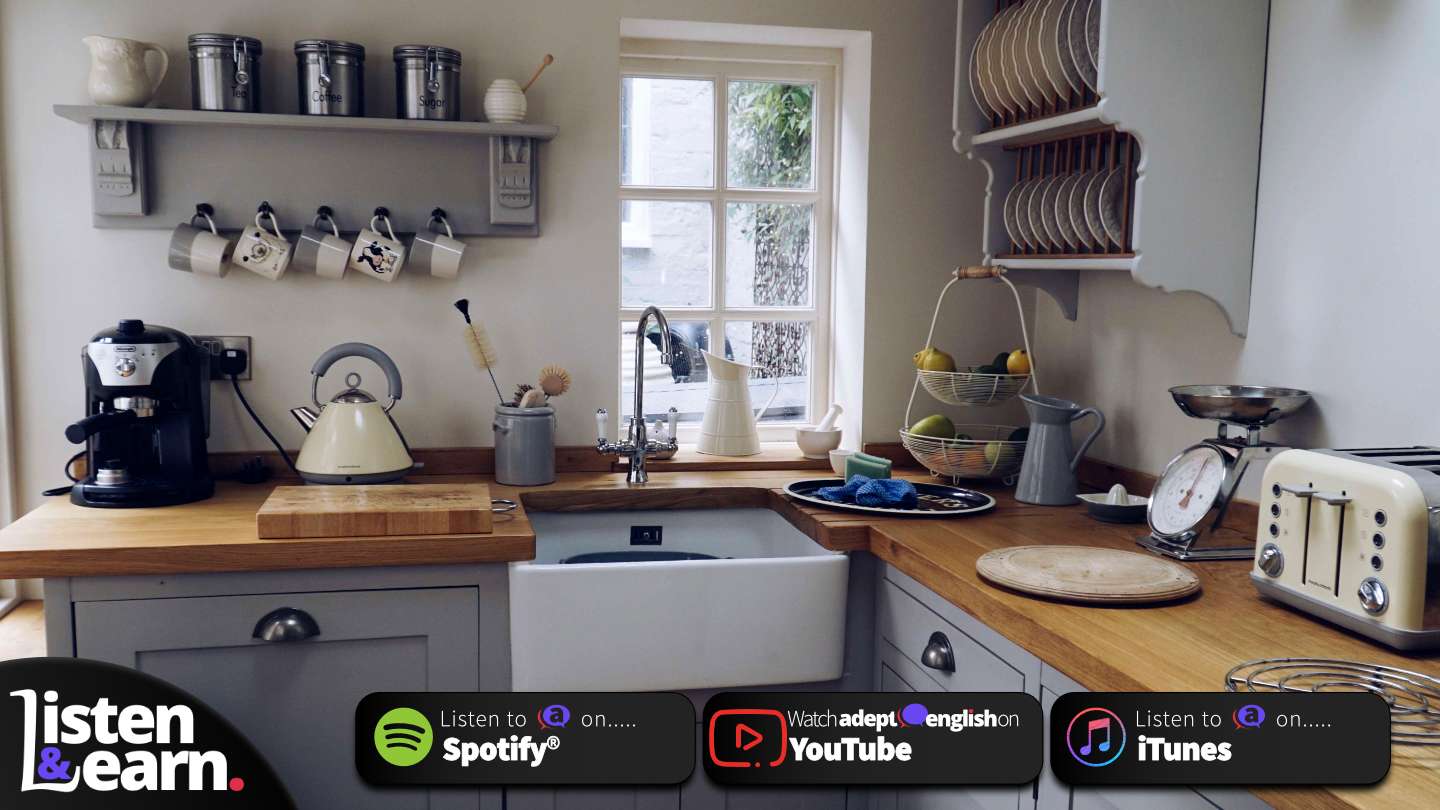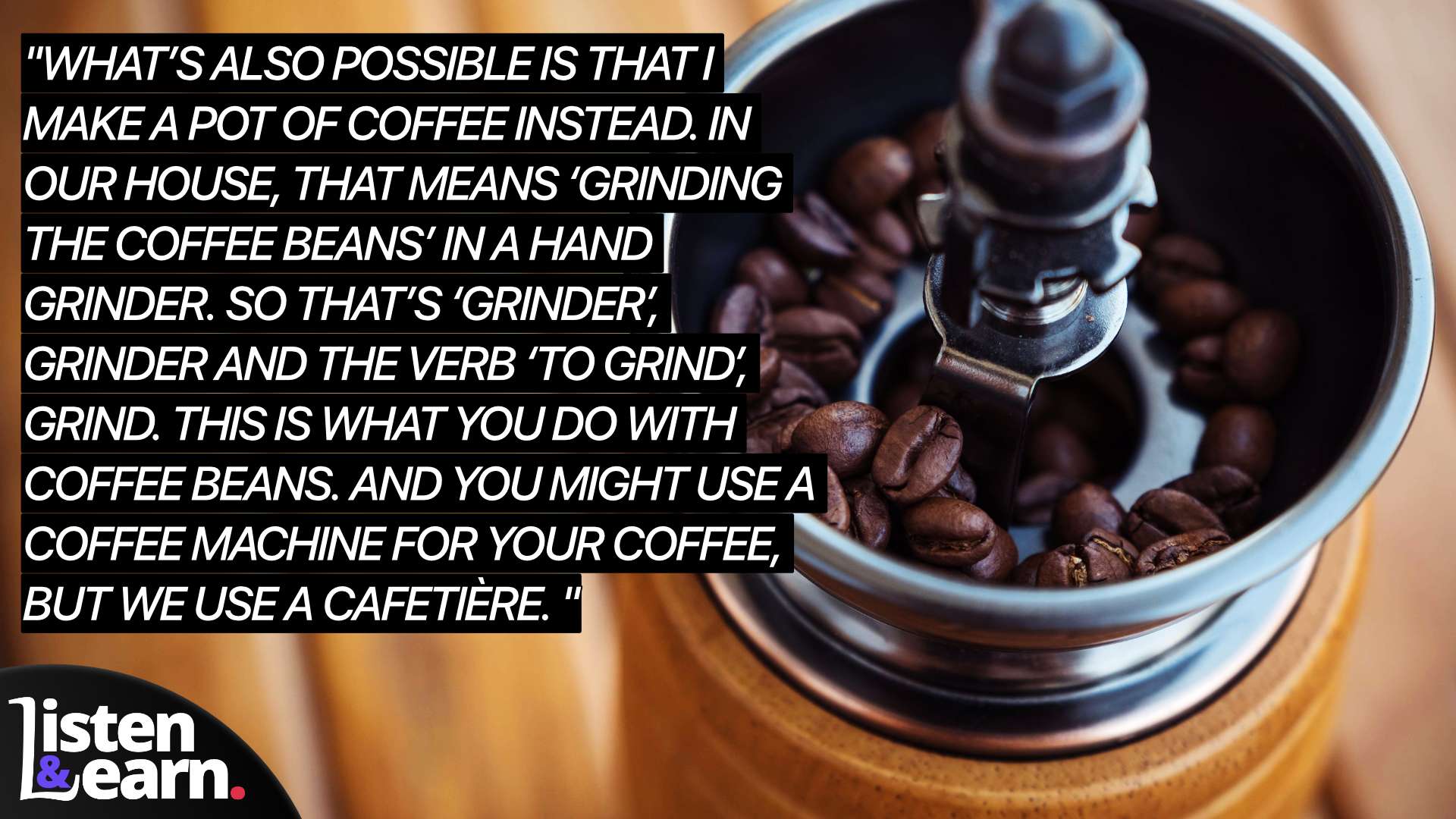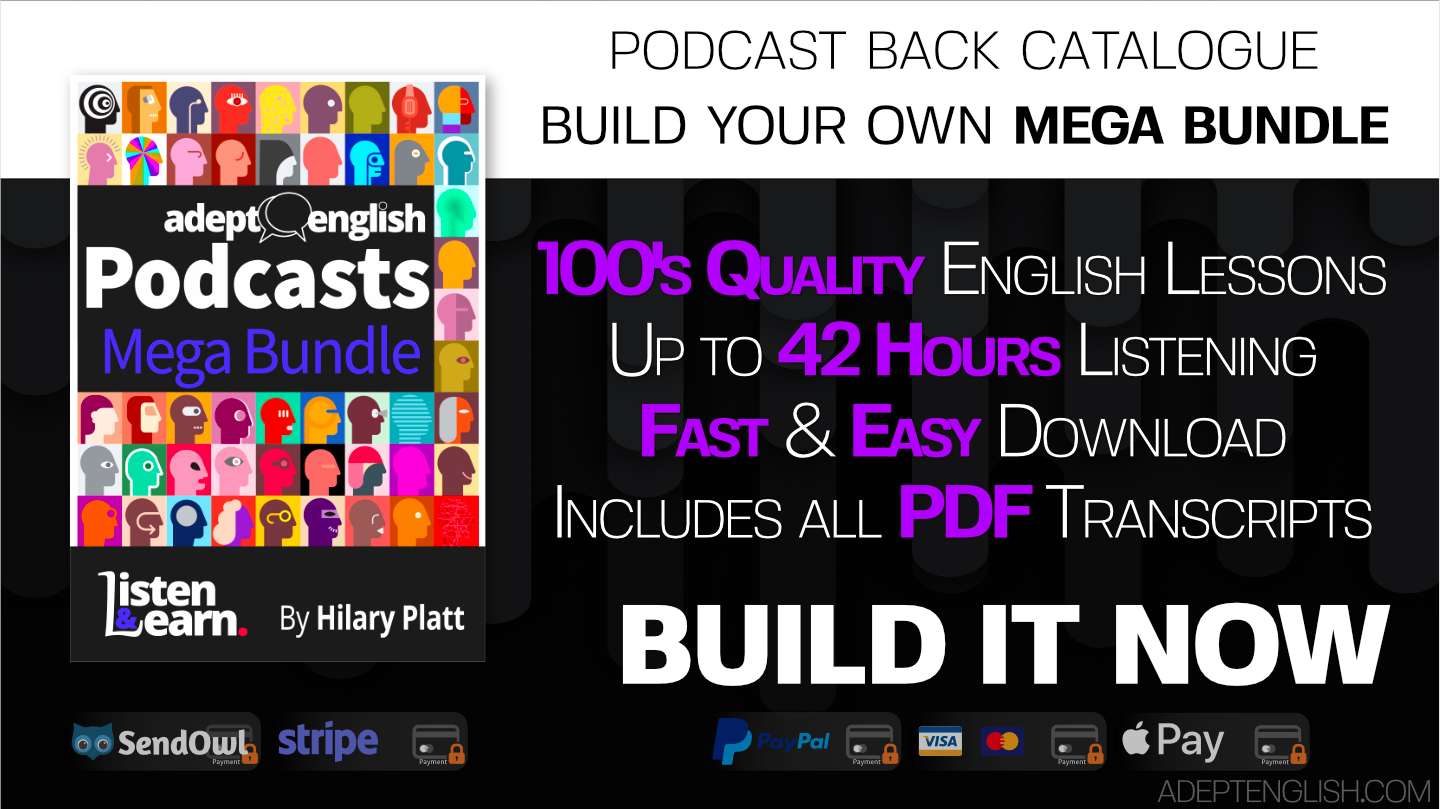Improve Your English Listening Skills With This Guide To British Kitchen Vocabulary And Pronunciation
This British breakfast vocabulary podcast for language learners will help you improve your comprehension and pronunciation of typical vocabulary and phrases for your morning food in the UK. All you have to do is listen and learn. Subscribe to our podcast, put your headphones on and start listening your way to better English language skills.
Do you want to learn about the British way of life? Would you like to take a closer look at the lifestyle of a British family? Are you curious about our shopping behaviour, what we British eat and drink and our daily routine?
If you really want to learn the culture of a country, you have to understand the way life happens there. This podcast helps the listener peek into an English kitchen and use phrases that are used there regularly.
Using the Adept English listen and learn approach is an exceptional way to improve your English language skills quickly. In each of our lessons, you can expect to listen to over 2,000 English words. All explained with context, pronounced correctly by a native English speaker.
All of our lessons are designed to keep you engaged, so that you are more likely to remember. We teach at a speed and with a clarity that language learners can follow. And don’t forget we provide free transcripts with every podcast lesson! Try us today and discover why over 600,000 English language learners follow our show.
Most Unusual Words:
Kitchen
Lifestyle
Clarity
Stove
Kettle
Pan
Fry
Toaster
Cafetière
Grinder
Toaster
Most common 2 word phrases:
| Phrase | Count |
|---|---|
| a pan | 4 |
| your hob | 4 |
| you can | 3 |
| you might | 3 |
| need to | 2 |
| will help | 2 |
| to know | 2 |
| use a | 2 |
| you use | 2 |
| to fry | 2 |
| to make | 2 |
Listen To The Audio Lesson Now
The mp3 audio and pdf transcript for this lesson is now part of the Adept English back catalogue . You can still download and listen to this lesson as part of one of our podcast bundles.Transcript: Learn The Vocabulary And Pronunciation Of A British Kitchen In English
Today I’m going to talk about ‘What’s in your kitchen?’ Some of you are interested not just in words for things in the workplace, or vocabulary that you might use to get a job in English or in how to conjugate irregular verbs. What you want to know is vocabulary for all kinds of things in the home. Objects in your kitchen, your bathroom. So here it is, by popular request. Some words for objects in your kitchen. Most of us cook - and all of us eat - so this is pretty universal as a topic.
Hello, I’m Hilary, and you’re listening to Adept English. We will help you to speak English fluently. All you have to do is listen. So start listening now and find out how it works.
If you’re learning English, these are the everyday objects that perhaps aren’t covered in your average English language course. These are the detailed day-to-day things that you use and which matter to you of course, if you’re living in an English speaking country, or if you need to speak English in the home.
There are lots of these words, so let’s see how far we get today. It’s better to learn a few words well, rather than me overload you with too many words. I’ll give you a little scenario, so that you can picture me in my kitchen, cooking some breakfast and that will help us include some of the words that you might need to know.
English vocabulary for making breakfast - kettle, hob, pan and toaster
So, if I arrive downstairs in the morning, having just woken up and showered and got dressed, what do I do first? Well, I will put on the kettle. That’s KETTLE - and that’s the device which you use for heating water for your cup of tea or your cup of coffee. Our kettle is electric but you can get ones which you heat like a pan, on your hob or stove.
Your hob, HOB is where you do most of your cooking - you put food in a pan and heat it on the hob. It’s a flat surface with heat - you might also call it your stove, STOVE. Your hob or stove might be electric or gas or ceramic perhaps - that’s still electric. So that’s kettle and hob covered.
And a pan, PAN? Well that’s a metal container, usually with a handle and possibly with a lid, LID to go on the top. And you can put a pan directly on your hob. And there are different types of pan, for instance you would use a saucepan if you wanted to make a sauce, some custard or some gravy - or to heat up your baked beans, your porridge or your soup. And you’d use a frying pan, to cook meat, fish, eggs or an omelette, perhaps. That’s FRYING, which is a gerund to make an adjective from the verb ‘to fry’, FRY. And ‘to fry’ means that you cook something in hot oil.
I don’t usually eat breakfast, but what I’m about to talk about does happen occasionally! You can add into this picture - I’ve put on the kettle to make a cup of tea - and now I’m going to do some eggs, frying on the hob, in a pan. And I’ve just put some sliced bread in the toaster. The toaster, TOASTER is like the kettle - an electrical appliance. And the job of a toaster is to toast or to brown my bread - to ‘make toast’. Or you could also put sliced hot crossed buns or crumpets in your toaster.
English vocabulary - making tea and coffee
So my eggs are frying nicely and my kettle is nearly boiling. That’s ‘to boil’, BOIL and that means it’s nearly bubbling, 100˚C. I might then get a mug, MUG for my tea - and reach into the kitchen cupboard, that’s CUPBOARD for a teabag. Most tea in the UK isn’t brewed the old fashioned way, using loose tea and teapot - that’s TEAPOT. No, we tend to use teabags. So tea in a little bag, which you throw away afterwards. I put my teabag into the cup and pour on the boiling water from the kettle.
What’s also possible is that I make a pot of coffee instead. In our house, that means ‘grinding the coffee beans’ in a hand grinder. So that’s ‘grinder’, GRINDER and the verb ‘to grind’, GRIND. This is what you do with coffee beans. And you might use a coffee machine for your coffee, but we use a cafetière. So that’s CAFETIERE. A cafetière, with an accent on the second E, is a jug for making coffee.
Usually glass, but ours is a French coffee pot, so it’s made of metal. There’s a mechanism in a cafetière for keeping the coffee ‘grinds’,away from and separate from the coffee. You don’t want those in the bottom of your mug. So some days, it might be coffee - and the ‘cafetière’, which is a French word, of course - there’s a little grave accent on the E, which tells you that, but we do use this word in English. And some days it might be a cup of English Breakfast Tea.
📷
A close up photo of a coffee bean grinder. If you want to sound like a British native, then learn from a native with fun English listening practice. Today’s breakfast vocabulary podcast is great for English listening practice.
Then I notice my toast has ‘popped’ - that’s the verb ‘to pop’, which we use for all kinds of things. But that means that the toaster has stopped toasting and the toast has appeared at the top of the toaster - it’s ‘popped’ or it’s ‘popped up’. I’ll then go over to the fridge - that’s FRIDGE, which is another electric appliance in my kitchen. A big white box like a cupboard with shelves and it’s cold inside my fridge, specifically about 4˚C in there! So I go over to my fridge - or ‘refrigerator’ if you want the full word, to get out the milk.
My preference is soya milk - special soya milk, if it’s coffee - Barista soya milk. And it’s possibly what you call ‘an acquired taste’ - meaning something that you have to get used to it, before you like it, which you have to grow accustomed to. So that’s soya milk. And whoops - by now my fried eggs are ready, so I need also to get the butter from the fridge as well. And perhaps also some sauce - either tomato ketchup or maybe even HP Sauce or brown sauce. That last one is called HP after the Houses of Parliament in Westminster in the UK.
English vocabulary - cutlery and crockery
What else do I need for my breakfast? Well, I don’t take sugar in my tea, but it’s sugar, SUGAR in case you do take it. And we’d talk about sugar in spoonfuls, that’s SPOONFUL, when making tea or coffee. How many spoonfuls of sugar do you have in your tea? And that’s of course, from the word ‘spoon’, SPOON. A spoon that you would eat with, perhaps.
The little spoon that you might use to stir your tea or your coffee or put your sugar in, is called a ‘teaspoon’ - made up of the words ‘tea’, TEA and ‘spoon’, SPOON. We might even talk about teaspoonfuls of sugar - so a compound word, TEASPOONFULS. While I’m on that topic, what I do before I eat my eggs on toast and drink my cup of tea.
Well, I will ‘set the table’. This means I make a ‘place setting’ at the table. Probably that would mean putting onto the table, where I’m going to sit and eat my eggs on toast - a table mat. That’s a table mat, MAT for under my hot plate and with it a knife and fork. That’s ‘knife’, KNIFE - this is what you cut up your food with and a fork, FORK. This is what you use to stab your food and put it into your mouth when you’re eating.
If I was going to eat pudding or dessert or cereal, then I might add a dessertspoon to my place setting, DESSERTSPOON. And if there was soup - very unlikely at breakfast time, I’d also add a soupspoon. One more type of spoon - if you have a large spoon for serving things at the table, for helping yourself to a portion of food from a large bowl or dish - that large spoon might be called a tablespoon, TABLESPOON or a serving spoon.
Altogether, as a group, these metal utensils for eating, for feeding yourself are known collectively as ‘cutlery’, that’s CUTLERY. And another term for all the pot items if you like, like your plate, PLATE or your bowl, BOWL or dish, DISH that you eat from, or your cup or mug that you drink from - they’re known collectively as ‘crockery’, CROCKERY. So your ‘cutlery’ is your knives, forks and spoons and your ‘crockery’ is your bowls, plates and dishes.
Video
English vocabulary - glassware
OK, so it’s all ready! I serve my eggs on toast - having first put butter on my toast, or you might say I’d ‘buttered my toast’ and my cup of tea is brewed or ready. If it’s the weekend or I’m feeling particularly lavish, I might decide that I’m going to have a glass, GLASS of orange juice with that too.
Again there are different types of glass, especially for alcoholic drinks. If it was a glass for fruit juice, I’d probably just use a tumbler, which is TUMBLER - that means a plain glass. If I was to drink wine - probably not at breakfast time - I would use a wineglass, WINEGLASS. And wineglasses usually have a stem, a narrow piece of glass joining the top and the base.
A reminder of Course One Activate Your Listening
Just a reminder that if you like learning English vocabulary like this in context, then our Course One Activate Your Listening not only gives you practice at English conversation with two speakers, but it also gives you lots of vocabulary on three main topics. The UK, food and education. Go to our website at adeptenglish.com, not only for the transcript for this podcast, but also to the Language-courses page to find out more about Course One Activate Your Listening.
Boost Your Learning With Adept English
English vocabulary for washing up
OK, what about when I’ve finished my breakfast? If there aren’t many dishes, I might decide to wash up in the kitchen sink, that’s SINK. The ‘sink’ is where you do your washing up. You can fill it with water. That’s what happens in the kitchen sink, anyway - and in the bathroom, the sink might be where you clean your teeth.
That would involve turning on the tap, TAP so that water flows into the sink, or if you prefer US English, the tap is called the ‘faucet’ in the US - that’s FAUCET. For washing up, I’d probably use some ‘washing up liquid’ - that’s the detergent that you use to wash up and make bubbles - ours is called ‘Fairy Liquid’. And if there are more dishes or I’m feeling less energetic, then I might put my dirty dishes, my dirty pots as we’d say into the dishwasher.
That’s the machine that washes the dishes - and again, another compound word is spelt DISHWASHER. And instead of washing up liquid there, I would use a dishwasher tablet, that’s TABLET or ‘dishwasher tab’ for short. Then, after such a good breakfast, I would be ready for my day!
Recap on English vocabulary for making breakfast
OK, let’s just recap there a minute. The words that I’ve used just so that you can remember them? Kettle, hob, stove, pan and lid to go with your pan. Then saucepan and frying pan. Toaster, cupboard, teapot, coffee grinder and cafetière. Coffee grinds, the fridge, tomato ketchup and HP sauce.
Download The Podcast Audio & Transcript
Then I covered sugar and the idea of teaspoons and teaspoonfuls. And I covered the rest of the cutlery - that’s knives, forks and spoons. And also different kinds of spoon - so not just teaspoons, but dessertspoons, soupspoons, tablespoons and serving spoons. Cutlery as the collective word for metal utensils and also remember crockery as the collective word for your plates, dishes and bowls.
I also talked about glasses - tumblers and wineglasses. And I covered washing up in the sink, sometimes called ‘doing the dishes’ and how I’d use the tap or faucet to turn the water on and probably some Fairy Liquid. Or I might use the dishwasher and a dishwasher tablet to do my washing up.
Goodbye
Hopefully it helps to have a little recap. How many of those words did you already know - and how many of the ones you didn’t know do you remember now? You know how this works! Listen to this podcast a number of times until you can remember more of this vocabulary. It’ll help you picturing me in my kitchen, making tea or coffee and cooking eggs on toast for breakfast.
Enough for now. Have a lovely day. Speak to you again soon. Goodbye.
Thank you so much for listening. Please help me tell others about this podcast by reviewing or rating it. And, please share it on social media. You can find more listening lessons and a free English course at adeptenglish.com








